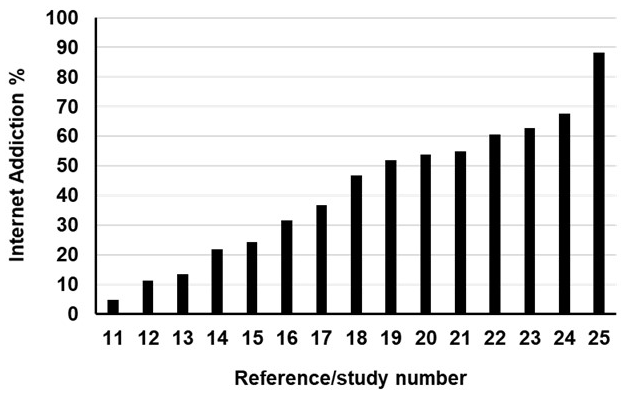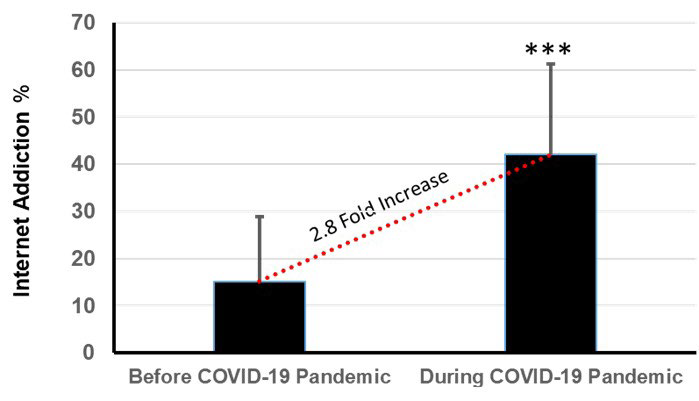1. Ayub S, Jain L, Parnia S, et al. Treatment modalities for inter net addiction in children and adolescents: A systematic review of randomized controlled trials (RCTs). J Clin Med. 2023; 12(9): 3345. doi: 10.3390/jcm12093345
2. Kirtipal N, Bharadwaj S, Kang SG. From SARS to SARSCoV-2, insights on structure, pathogenicity and immunity aspects of pandemic human coronaviruses. Infect Genet Evol. 2020; 85: 104502. doi: 10.1016/j.meegid.2020.104502
3. Bao Y, Sun Y, Meng S, Shi J, Lu L. 2019-nCoV epidemic: Address mental health care to empower society. Lancet. 2020; 395(10224): e37-e38. doi: 10.1016/S0140-6736(20)30309-3
4. Marin MG, Nuñez X, de Almeida RMM. Internet addiction and attention in adolescents: A systematic review. Cyberpsychol Behav Soc Netw. 2021; 24(4): 237-249. doi: 10.1089/cyber.2019.0698
5. Shi L, Lu ZA, Que JY, et al. Prevalence of and risk factors associated with mental health symptoms among the general population in China during the coronavirus disease 2019 pandemic. JAMA Netw Open. 2020; 3(7): e2014053. doi: 10.1001/jamanetworkopen.2020.14053
6. Liu JJ, Bao Y, Huang X, Shi J, Lu L. Mental health considerations for children quarantined because of COVID-19. Lancet Child Adolesc Health. 2020; 4(5): 347-349. doi: 10.1016/S2352- 4642(20)30096-1
7. Ryan P. Technology: The new addiction. Paper presented at: US Naval Institute Publications; September 2018; 144: e387. MD, USA. Website. https://www.usni.org/magazines/proceedings/2018/september/technology-new-addiction. Accessed June 3, 2022.
8. Smith A, Anderson M. Social Media Use in 2018. 2018. Website. https://policycommons.net/artifacts/617452/social-media-use-in-2018/1598263/. Accessed July 9, 2023.
9. Dresp-Langley B, Hutt A. Digital addiction and sleep. Int J Environ Res Public Health. 2022; 19(11): 6910. doi: 10.3390/ ijerph19116910
10. Degenhard J. Number of smartphone users worldwide 2013 to 2028. 2023. Website. https://www.statista.com/forecasts/1143723/smartphone-users-in-the-world. Published June 1, 2023. Accessed July 9, 2023.
11. Ozturk FO, Ayaz-Alkaya S. Internet addiction and psychosocial problems among adolescents during the COVID-19 pandemic: A cross-sectional study. Arch Psychiatr Nurs. 2021; 35(6): 595-601. doi: 10.1016/j.apnu.2021.08.007
12. Lee JJ, Shin SH. Associations between Fear of COVID-19, depression, and Internet addiction in South Korean Adults. Healthcare (Basel). 2022; 10(5): 861. doi: 10.3390/healthcare10050861
13. Kumar G, Dash P, Jnaneswar A, Suresan V, Jha K, Ghosal S. Impact of Internet addiction during COVID-19 on anxiety and sleep quality among college students of Bhubaneswar city. J Educ Health Promot. 2022; 11: 156. doi: 10.4103/jehp.jehp_396_21
14. Rouleau RD, Beauregard C, Beaudry V. A rise in social media use in adolescents during the COVID-19 pandemic: The French validation of the Bergen Social Media Addiction Scale in a Canadian cohort. BMC Psychol. 2023; 11: 92. doi: 10.1186/s40359- 023-01141-2
15. Lin MP. Prevalence of Internet addiction during the COVID-19 outbreak and its risk factors among junior high school students in Taiwan. Int J Environ Res Public Health. 2020; 17(22): 8547. doi: 10.3390/ijerph17228547
16. Alheneidi H, AlSumait L, AlSumait D, Smith AP. Loneliness and problematic internet use during COVID-19 lock-down. Behav Sci (Basel). 2021; 11(1): 5. doi: 10.3390/bs11010005
17. Li YY, Sun Y, Meng SQ, et al. Internet addiction increases in the general population during COVID-19: Evidence from China. Am J Addict. 2021; 30(4): 389-397. doi: 10.1111/ajad.13156
18. Sun Y, Li Y, Bao Y, et al. Brief report: Increased addictive internet and substance use behavior during the COVID-19 pandemic in China. Am J Addict. 2020; 29(4): 268-270. doi: 10.1111/ ajad.13066
19. Siste K, Hanafi E, Sen LT, et al. The impact of physical distancing and associated factors towards Internet addiction among adults in Indonesia during COVID-19 pandemic: A nationwide web-based study. Front Psychiatry. 2020; 11: 580977. doi: 10.3389/ fpsyt.2020.580977
20. Zhang Y, Hou Z, Wu S, Li X, Hao M, Wu X. The relationship between Internet addiction and aggressive behavior among adolescents during the COVID-19 pandemic: Anxiety as a mediator. Acta Psychol (Amst). 2022; 227: 103612. doi: 10.1016/j.actpsy.2022.103612
21. Khubchandani J, Sharma S, Price JH. COVID-19 pandemic and the burden of Internet addiction in the United States. Psychiatry Int.2021; 2(4): 402-409. doi: 10.3390/psychiatryint2040031
22. Schoultz M, Lamph G, Thygesen H, et al. Perceptions of social media challenges and benefits during the Covid-19 pandemic: Qualitative findings from a cross sectional international survey. PLOS Glob Public Health. 2023; 3(1): e0001463. doi: 10.1371/journal.pgph.0001463
23. Priego-Parra BA, Triana-Romero A, Pinto-Gálvez SM, et al. Anxiety, depression, attitudes, and Internet addiction during the initial phase of the 2019 coronavirus disease (COVID-19) epidemic: A cross-sectional study in México. MedRxiv. 2020; 1-27. doi: 10.1101/2020.05.10.20095844
24. Tahir MJ, Malik NI, Ullah I, et al. Internet addiction and sleep quality among medical students during the COVID-19 pandemic: A multinational cross-sectional survey. PLoS One. 2021; 16(11): e0259594. doi: 10.1371/journal.pone.0259594
25. Onukwuli VO, Onyinye EN, Udigwe IB, Umeh UM, Enebe JT, Umerah AT. Internet addiction during the COVID-19 pandemic among adolescents in southeast Nigeria and implications for adolescent care in the post-pandemic era: A cross-sectional study. SAGE Open Med. 2023; 11: 20503121231152763. doi: 10.1177/20503121231152763
26. Weinstein A, Lejoyeux M. Internet addiction or excessive internet use. Am J Drug Alcohol Abuse. 2010; 36(5): 277-283. doi: 10.3109/00952990.2010.491880
27. Duong XL, Liaw SY, Augustin JPM. How has Internet addiction been tracked over the last decade? A literature review and 3C paradigm for future research. Int J Prev Med. 2020; 11: 175. doi: 10.4103/ijpvm.IJPVM_212_20
28. Poli R. Internet addiction update: Diagnostic criteria, assessment and prevalence. Neuropsychiatry. 2017; 7(1): 4-8.doi:10.4172/Neuropsychiatry.1000171
29. Chung S, Lee HK. Public health approach to problems related to excessive and addictive use of the internet and digital media. Curr Addict Rep. 2023; 10(1): 69-76. doi: 10.1007/s40429- 022-00458-z
30. Boehm E, Kronig I, Neher RA, Eckerle I, Vetter P, Kaiser L. Geneva Centre for Emerging Viral Diseases. Novel SARS-CoV-2 variants: The pandemics within the pandemic. Clin Microbiol Infect. 2021; 27(8): 1109-1117. doi: 10.1016/j.cmi.2021.05.022
31. Thoradeniya T, Jayasinghe S. COVID-19 and future pandemics: A global systems approach and relevance to SDGs. Global Health. 2021; 17(1): 59. doi: 10.1186/s12992-021-00711-6
32. Zhao F, Bali S, Kovacevic R, Weintraub J. A three-layer system to win the war against COVID-19 and invest in health systems of the future. BMJ Glob Health. 2021; 6(12): e007365. doi: 10.1136/bmjgh-2021-007365







